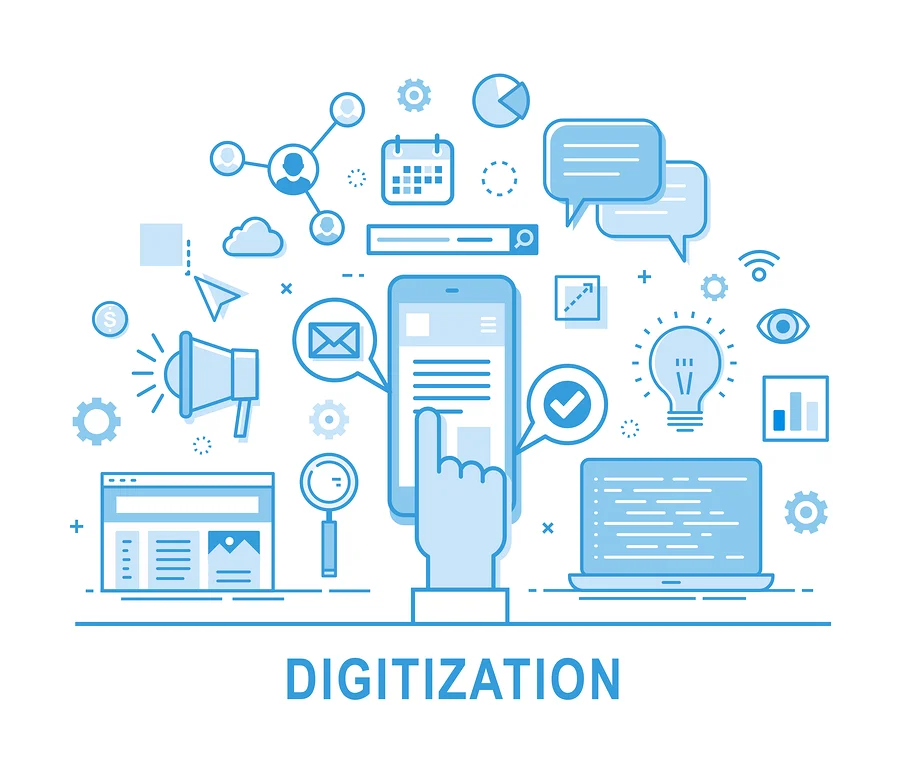Digital Transformation Revolution

As the use of the term digital transformation has become more commonplace, many wonder if it is here to stay, or if it is merely another buzzword that will soon be a distant memory. What exactly does the term digital transformation even mean?
The Enterprisers Project defines digital transformation as, “The integration of digital technology into all areas of a business, fundamentally changing how businesses operate and deliver value to customers.” Beyond the impact that digital transformation has on business operations, digital technology has significantly shifted society’s mindset altogether — creating an expectation from consumers for more accessible and seamless communication.
Nearly all of us have felt the impact of digital transformation from the interactions in our day-to-day personal or professional lives — from interactive teller machines (ITMs) appearing at local community bank branches to virtual visit technology being deployed by doctors’ offices around the country. Innovations such as the cloud, artificial intelligence (AI), internet of things (IoT) and big data have already dramatically altered the customer experience in many, if not all, industries.
Response to Digital Transformation
Although talk of digital transformation seems to be a recent hot topic, the trend has been developing and impacting communications (both professional and personal) for nearly 30 years.
Beginning with the invention of the World Wide Web in 1989 and continuing right up to this very moment, innovative technology continues to emerge at a rapid pace. As societal norms begin to catch up with the enormous amount of transformation that has occurred technologically, it’s important to consider the reaction that specific industries have had to such drastic change.
With any type of significant change, it is human nature to fear the unknown. Of course, while change is inevitable, suffering is optional. A common reaction to rapid technological change is disbelief. Many have difficulty accepting that innovative technology is here to stay and will continue to adapt in the future. To cite Robert E. Lee, “The education of a man is never completed until he dies.” When you consider that technology will continue sparking digital transformation well into the future, this is certainly true.
I remember a time back when I was selling fax machines in 1991. I entered an office completely filled with file cabinets, and the business owner said quite confidently, “We’ll never use a fax machine.” We’re all aware that fax machines have come and gone — and so too has this particular business. It’s not a matter of believing in the technology — it’s a matter of whether a business wants to merely survive or thrive. If a business wants to thrive, it must get on board with digital solutions early on. There will be survivors that adapt and doubters that steadfastly refuse and subsequently go out of business. History will continue to repeat itself with each new form of emerging technology. So it’s important for businesses to embrace their continued digital transformation.
The Influence on Vertical Industries
Perhaps the place where digital transformation has made its most notable impact has been in vertical industries such as healthcare and banking. The healthcare industry has experienced massive amounts of change as a direct result of digital transformation in the last 10 years alone — from the growing popularity and use of telehealth solutions to EHRs’ elimination of messy paper records. Studies show that patients are already ready and willing to embrace this transformation — “77 percent of patients are willing to conduct a virtual care encounter, and 19 percent of patients have already done so.”
Growing consumer expectations for 24/7/365 mobile access to information has also had a significant influence over the banking industry leading to rapid digital progress of mobile banking applications and peer-to-peer payments (P2P). This progress is only set to continue on into the future. According to Business Insider, by 2021 $336 billion will be transferred via mobile P2P payments, up from just $60 billion in 2017.
The Potential Risk
Despite the evolution of digital transformation in vertical industries such as healthcare and banking, new challenges continue to arise in response to the trend — security challenges are perhaps the most concerning and pertinent to consumers. In fact, Frost & Sullivan conducted a survey that noted when “navigating digital transformation globally, 32 percent of IT professionals cited security concerns as their top challenge.” As digitization increases the amount of data that exists in the cloud, confidential consumer data becomes at risk for cyberattack. In response to the digital transformation that has occurred, vertical industries must take measures to tighten up security practices to ensure that private consumer information is protected.
Although digital transformation can indeed have a profoundly positive impact on the way in which our society conducts business and communicates interpersonally, digital transformation can be just as painful as it is beneficial — but it’s necessary for businesses to survive.
